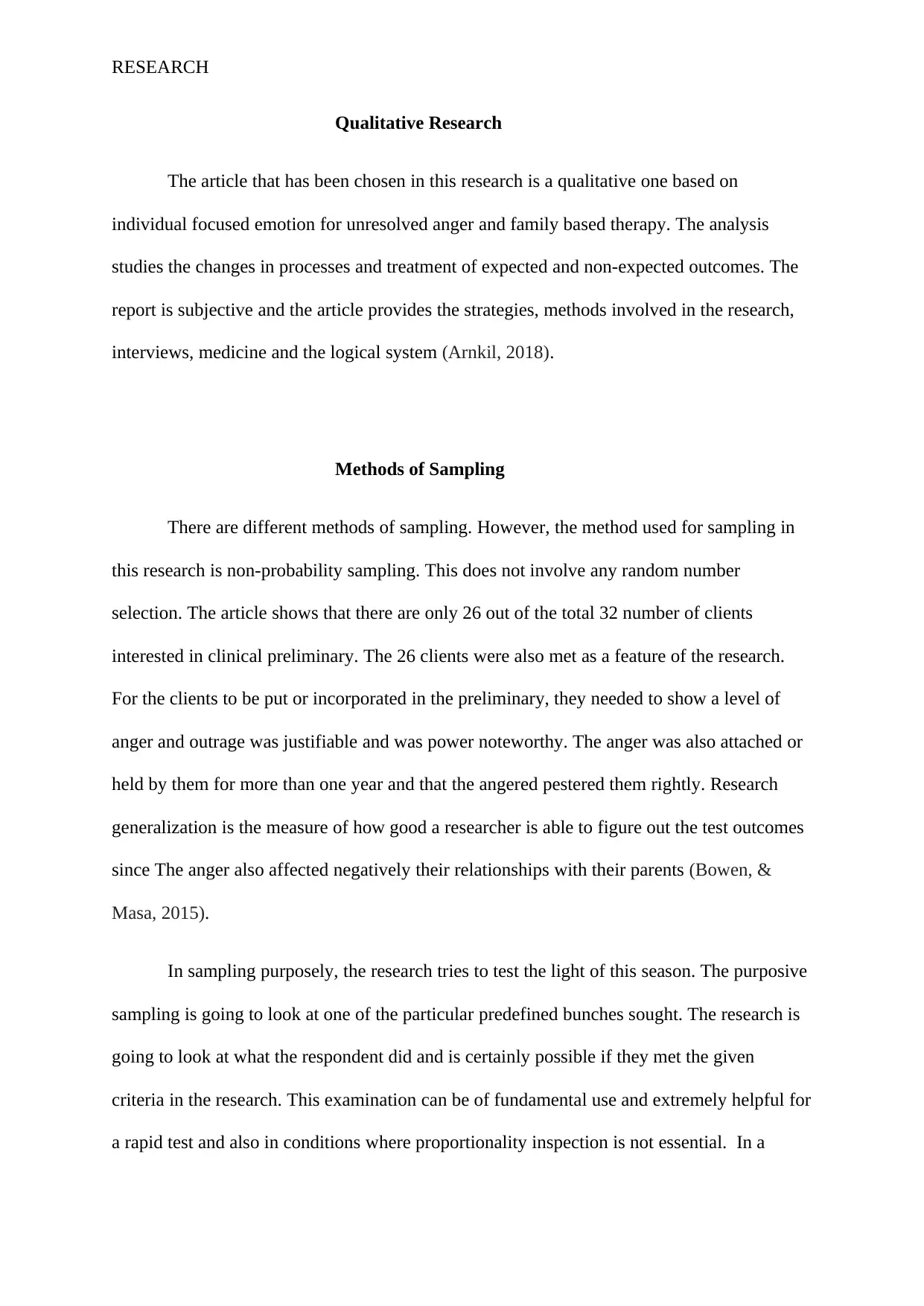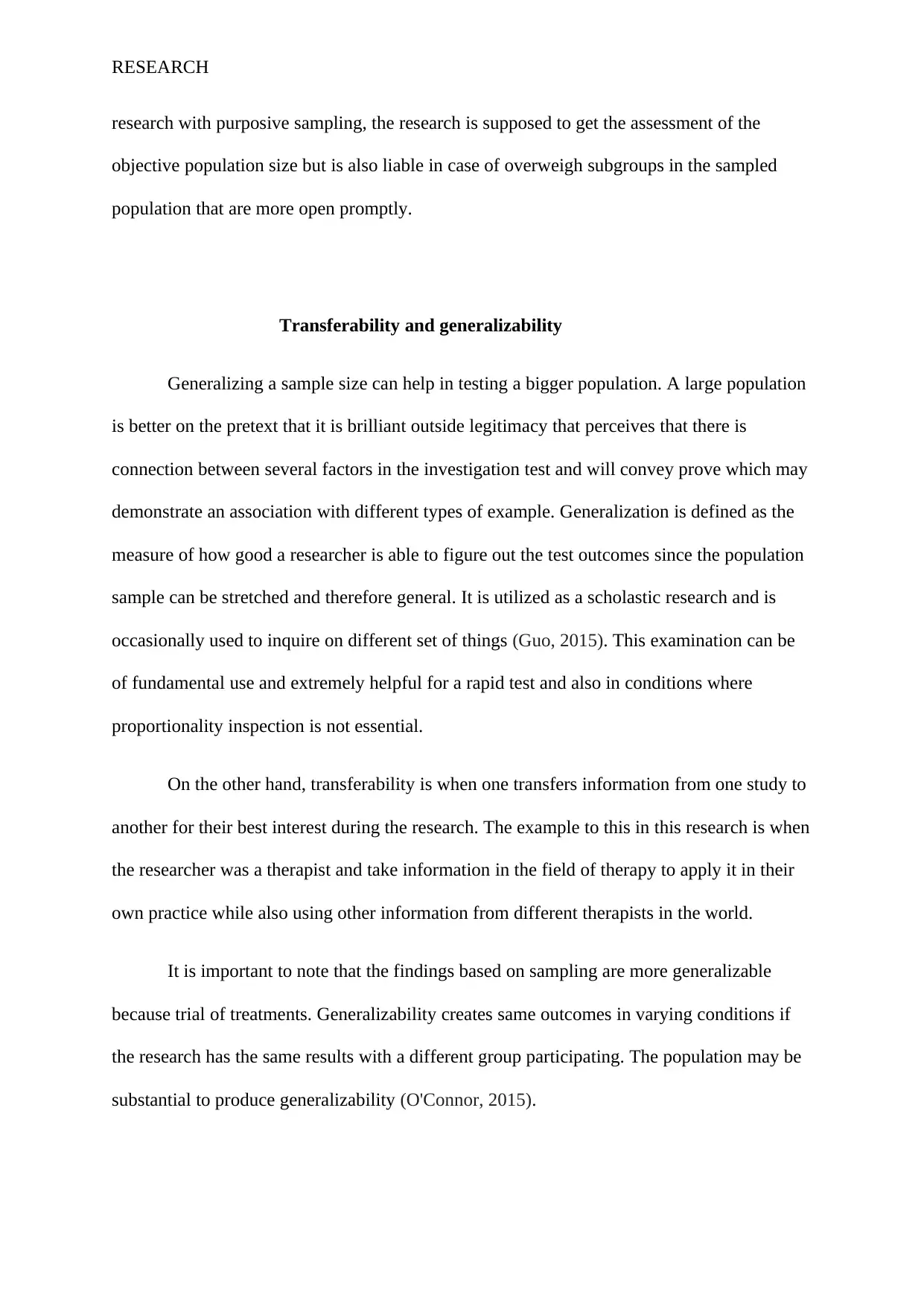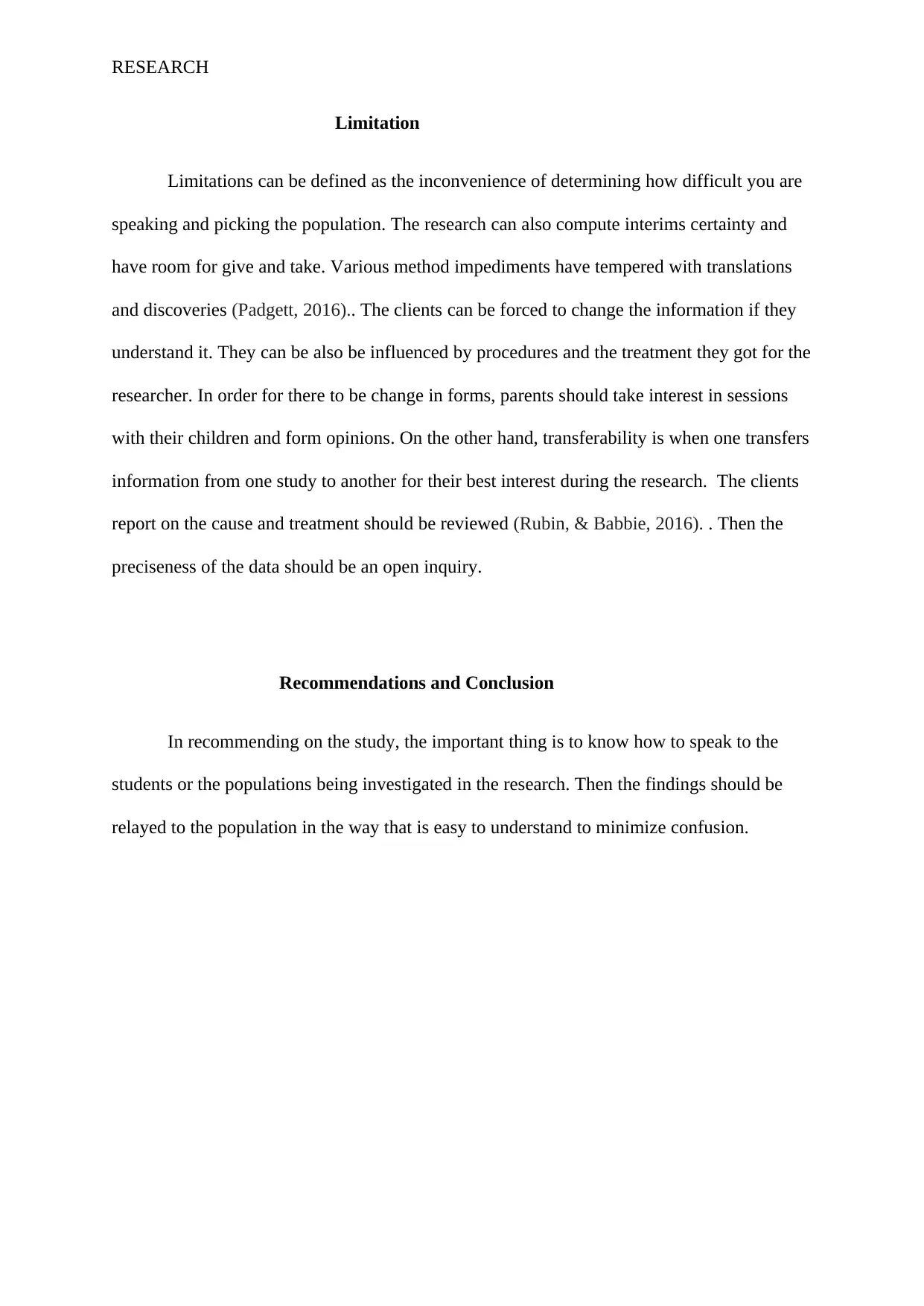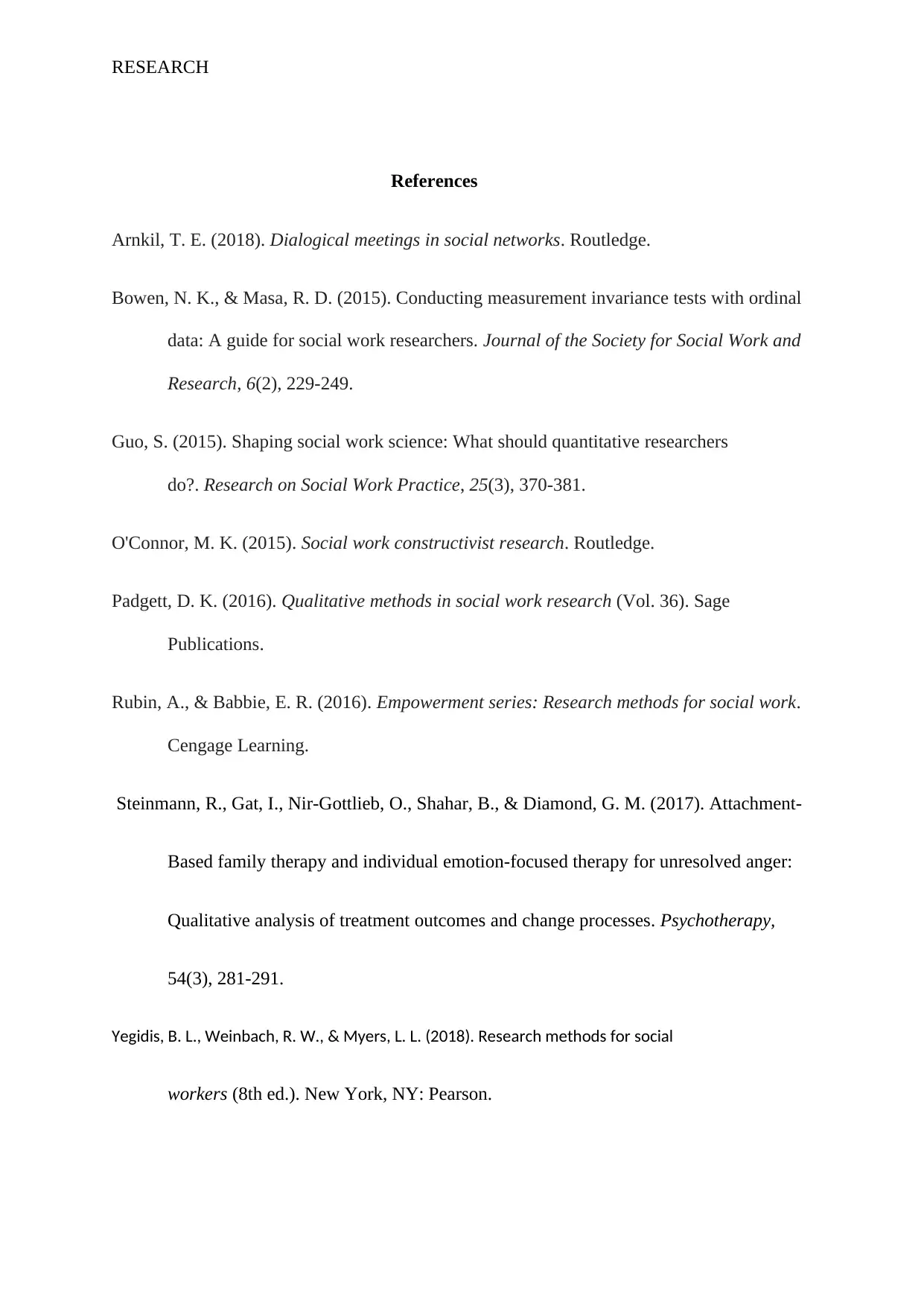Attachment-Based Therapy Research: Outcomes and Change Processes
VerifiedAdded on 2022/11/29
|8
|1082
|133
Report
AI Summary
This report provides a comprehensive analysis of a qualitative research article focusing on attachment-based family therapy and individual emotion-focused therapy for unresolved anger. The research employs non-probability sampling, specifically purposive sampling, to examine the treatment outcomes and change processes. The study explores generalizability and transferability of findings, while also acknowledging limitations related to client information and potential biases. The report highlights the importance of clear communication of research findings and discusses recommendations for future studies in the field of social work practice. The report also critiques the research design and sampling methods used in the study, including a discussion of how the chosen method may impact the generalizability of the findings.

Running head: RESEARCH
Social Work Practice Research
Name:
Institution:
Date:
.
Social Work Practice Research
Name:
Institution:
Date:
.
Paraphrase This Document
Need a fresh take? Get an instant paraphrase of this document with our AI Paraphraser

RESEARCH
Qualitative Research
The article that has been chosen in this research is a qualitative one based on
individual focused emotion for unresolved anger and family based therapy. The analysis
studies the changes in processes and treatment of expected and non-expected outcomes. The
report is subjective and the article provides the strategies, methods involved in the research,
interviews, medicine and the logical system (Arnkil, 2018).
Methods of Sampling
There are different methods of sampling. However, the method used for sampling in
this research is non-probability sampling. This does not involve any random number
selection. The article shows that there are only 26 out of the total 32 number of clients
interested in clinical preliminary. The 26 clients were also met as a feature of the research.
For the clients to be put or incorporated in the preliminary, they needed to show a level of
anger and outrage was justifiable and was power noteworthy. The anger was also attached or
held by them for more than one year and that the angered pestered them rightly. Research
generalization is the measure of how good a researcher is able to figure out the test outcomes
since The anger also affected negatively their relationships with their parents (Bowen, &
Masa, 2015).
In sampling purposely, the research tries to test the light of this season. The purposive
sampling is going to look at one of the particular predefined bunches sought. The research is
going to look at what the respondent did and is certainly possible if they met the given
criteria in the research. This examination can be of fundamental use and extremely helpful for
a rapid test and also in conditions where proportionality inspection is not essential. In a
Qualitative Research
The article that has been chosen in this research is a qualitative one based on
individual focused emotion for unresolved anger and family based therapy. The analysis
studies the changes in processes and treatment of expected and non-expected outcomes. The
report is subjective and the article provides the strategies, methods involved in the research,
interviews, medicine and the logical system (Arnkil, 2018).
Methods of Sampling
There are different methods of sampling. However, the method used for sampling in
this research is non-probability sampling. This does not involve any random number
selection. The article shows that there are only 26 out of the total 32 number of clients
interested in clinical preliminary. The 26 clients were also met as a feature of the research.
For the clients to be put or incorporated in the preliminary, they needed to show a level of
anger and outrage was justifiable and was power noteworthy. The anger was also attached or
held by them for more than one year and that the angered pestered them rightly. Research
generalization is the measure of how good a researcher is able to figure out the test outcomes
since The anger also affected negatively their relationships with their parents (Bowen, &
Masa, 2015).
In sampling purposely, the research tries to test the light of this season. The purposive
sampling is going to look at one of the particular predefined bunches sought. The research is
going to look at what the respondent did and is certainly possible if they met the given
criteria in the research. This examination can be of fundamental use and extremely helpful for
a rapid test and also in conditions where proportionality inspection is not essential. In a

RESEARCH
research with purposive sampling, the research is supposed to get the assessment of the
objective population size but is also liable in case of overweigh subgroups in the sampled
population that are more open promptly.
Transferability and generalizability
Generalizing a sample size can help in testing a bigger population. A large population
is better on the pretext that it is brilliant outside legitimacy that perceives that there is
connection between several factors in the investigation test and will convey prove which may
demonstrate an association with different types of example. Generalization is defined as the
measure of how good a researcher is able to figure out the test outcomes since the population
sample can be stretched and therefore general. It is utilized as a scholastic research and is
occasionally used to inquire on different set of things (Guo, 2015). This examination can be
of fundamental use and extremely helpful for a rapid test and also in conditions where
proportionality inspection is not essential.
On the other hand, transferability is when one transfers information from one study to
another for their best interest during the research. The example to this in this research is when
the researcher was a therapist and take information in the field of therapy to apply it in their
own practice while also using other information from different therapists in the world.
It is important to note that the findings based on sampling are more generalizable
because trial of treatments. Generalizability creates same outcomes in varying conditions if
the research has the same results with a different group participating. The population may be
substantial to produce generalizability (O'Connor, 2015).
research with purposive sampling, the research is supposed to get the assessment of the
objective population size but is also liable in case of overweigh subgroups in the sampled
population that are more open promptly.
Transferability and generalizability
Generalizing a sample size can help in testing a bigger population. A large population
is better on the pretext that it is brilliant outside legitimacy that perceives that there is
connection between several factors in the investigation test and will convey prove which may
demonstrate an association with different types of example. Generalization is defined as the
measure of how good a researcher is able to figure out the test outcomes since the population
sample can be stretched and therefore general. It is utilized as a scholastic research and is
occasionally used to inquire on different set of things (Guo, 2015). This examination can be
of fundamental use and extremely helpful for a rapid test and also in conditions where
proportionality inspection is not essential.
On the other hand, transferability is when one transfers information from one study to
another for their best interest during the research. The example to this in this research is when
the researcher was a therapist and take information in the field of therapy to apply it in their
own practice while also using other information from different therapists in the world.
It is important to note that the findings based on sampling are more generalizable
because trial of treatments. Generalizability creates same outcomes in varying conditions if
the research has the same results with a different group participating. The population may be
substantial to produce generalizability (O'Connor, 2015).
⊘ This is a preview!⊘
Do you want full access?
Subscribe today to unlock all pages.

Trusted by 1+ million students worldwide

RESEARCH
Limitation
Limitations can be defined as the inconvenience of determining how difficult you are
speaking and picking the population. The research can also compute interims certainty and
have room for give and take. Various method impediments have tempered with translations
and discoveries (Padgett, 2016).. The clients can be forced to change the information if they
understand it. They can be also be influenced by procedures and the treatment they got for the
researcher. In order for there to be change in forms, parents should take interest in sessions
with their children and form opinions. On the other hand, transferability is when one transfers
information from one study to another for their best interest during the research. The clients
report on the cause and treatment should be reviewed (Rubin, & Babbie, 2016). . Then the
preciseness of the data should be an open inquiry.
Recommendations and Conclusion
In recommending on the study, the important thing is to know how to speak to the
students or the populations being investigated in the research. Then the findings should be
relayed to the population in the way that is easy to understand to minimize confusion.
Limitation
Limitations can be defined as the inconvenience of determining how difficult you are
speaking and picking the population. The research can also compute interims certainty and
have room for give and take. Various method impediments have tempered with translations
and discoveries (Padgett, 2016).. The clients can be forced to change the information if they
understand it. They can be also be influenced by procedures and the treatment they got for the
researcher. In order for there to be change in forms, parents should take interest in sessions
with their children and form opinions. On the other hand, transferability is when one transfers
information from one study to another for their best interest during the research. The clients
report on the cause and treatment should be reviewed (Rubin, & Babbie, 2016). . Then the
preciseness of the data should be an open inquiry.
Recommendations and Conclusion
In recommending on the study, the important thing is to know how to speak to the
students or the populations being investigated in the research. Then the findings should be
relayed to the population in the way that is easy to understand to minimize confusion.
Paraphrase This Document
Need a fresh take? Get an instant paraphrase of this document with our AI Paraphraser

RESEARCH
References
Arnkil, T. E. (2018). Dialogical meetings in social networks. Routledge.
Bowen, N. K., & Masa, R. D. (2015). Conducting measurement invariance tests with ordinal
data: A guide for social work researchers. Journal of the Society for Social Work and
Research, 6(2), 229-249.
Guo, S. (2015). Shaping social work science: What should quantitative researchers
do?. Research on Social Work Practice, 25(3), 370-381.
O'Connor, M. K. (2015). Social work constructivist research. Routledge.
Padgett, D. K. (2016). Qualitative methods in social work research (Vol. 36). Sage
Publications.
Rubin, A., & Babbie, E. R. (2016). Empowerment series: Research methods for social work.
Cengage Learning.
Steinmann, R., Gat, I., Nir-Gottlieb, O., Shahar, B., & Diamond, G. M. (2017). Attachment-
Based family therapy and individual emotion-focused therapy for unresolved anger:
Qualitative analysis of treatment outcomes and change processes. Psychotherapy,
54(3), 281-291.
Yegidis, B. L., Weinbach, R. W., & Myers, L. L. (2018). Research methods for social
workers (8th ed.). New York, NY: Pearson.
References
Arnkil, T. E. (2018). Dialogical meetings in social networks. Routledge.
Bowen, N. K., & Masa, R. D. (2015). Conducting measurement invariance tests with ordinal
data: A guide for social work researchers. Journal of the Society for Social Work and
Research, 6(2), 229-249.
Guo, S. (2015). Shaping social work science: What should quantitative researchers
do?. Research on Social Work Practice, 25(3), 370-381.
O'Connor, M. K. (2015). Social work constructivist research. Routledge.
Padgett, D. K. (2016). Qualitative methods in social work research (Vol. 36). Sage
Publications.
Rubin, A., & Babbie, E. R. (2016). Empowerment series: Research methods for social work.
Cengage Learning.
Steinmann, R., Gat, I., Nir-Gottlieb, O., Shahar, B., & Diamond, G. M. (2017). Attachment-
Based family therapy and individual emotion-focused therapy for unresolved anger:
Qualitative analysis of treatment outcomes and change processes. Psychotherapy,
54(3), 281-291.
Yegidis, B. L., Weinbach, R. W., & Myers, L. L. (2018). Research methods for social
workers (8th ed.). New York, NY: Pearson.

RESEARCH
⊘ This is a preview!⊘
Do you want full access?
Subscribe today to unlock all pages.

Trusted by 1+ million students worldwide

RESEARCH
Paraphrase This Document
Need a fresh take? Get an instant paraphrase of this document with our AI Paraphraser

RESEARCH
1 out of 8
Related Documents
Your All-in-One AI-Powered Toolkit for Academic Success.
+13062052269
info@desklib.com
Available 24*7 on WhatsApp / Email
![[object Object]](/_next/static/media/star-bottom.7253800d.svg)
Unlock your academic potential
Copyright © 2020–2025 A2Z Services. All Rights Reserved. Developed and managed by ZUCOL.





